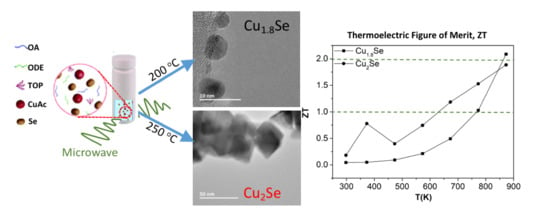Composition Tuning of Nanostructured Binary Copper Selenides through Rapid Chemical Synthesis and Their Thermoelectric Property Evaluation
Abstract
1. Introduction
2. Materials and Methods
2.1. Materials
2.2. Synthesis and Consolidation of Cu2−xSe
2.3. Characterization Methods
2.3.1. Transport Property Measurements
2.3.2. Structural and Morphological Characterization
2.4. Band Structure Calculations
3. Results and Discussion
where x = 0, or 0.2
3.1. Structural Analysis
3.2. XPS Analyses
3.3. SEM and TEM Analyses
3.4. Electronic Transport Properties
4. Conclusions
Supplementary Materials
Author Contributions
Funding
Acknowledgments
Conflicts of Interest
References
- Rowe, D.M. Thermoelectrics handbook-macro to nano. IEEE Electr. Insul. Mag. 2007, 23. [Google Scholar] [CrossRef]
- Kim, S., II; Lee, K.H.; Mun, H.A.; Kim, H.S.; Hwang, S.W.; Roh, J.W.; Yang, D.J.; Shin, W.H.; Li, X.S.; Lee, Y.H.; et al. Dense dislocation arrays embedded in grain boundaries for high-performance bulk thermoelectrics. Science 2015, 348, 109–114. [Google Scholar] [CrossRef]
- Pei, Y.; Shi, X.; LaLonde, A.; Wang, H.; Chen, L.; Snyder, G.J. Convergence of electronic bands for high performance bulk thermoelectrics. Nature 2011, 473, 66–69. [Google Scholar] [CrossRef]
- Zheng, X.F.; Liu, C.X.; Yan, Y.Y.; Wang, Q. A review of thermoelectrics research—Recent developments and potentials for sustainable and renewable energy applications. Renew. Sustain. Energy Rev. 2014, 32, 486–503. [Google Scholar] [CrossRef]
- Zhu, T.; Fu, C.; Xie, H.; Liu, Y.; Zhao, X. High efficiency half-heusler thermoelectric materials for energy harvesting. Adv. Energy Mater. 2015, 5, 1500588. [Google Scholar] [CrossRef]
- Zong, P.A.; Hanus, R.; Dylla, M.; Tang, Y.; Liao, J.; Zhang, Q.; Snyder, G.J.; Chen, L. Skutterudite with graphene-modified grain-boundary complexion enhances zT enabling high-efficiency thermoelectric device. Energy Environ. Sci. 2017, 10, 183–191. [Google Scholar] [CrossRef]
- Liu, W.; Tan, X.; Yin, K.; Liu, H.; Tang, X.; Shi, J.; Zhang, Q.; Uher, C. Convergence of conduction bands as a means of enhancing thermoelectric performance of n-type Mg2Si1−xSnx solid solutions. Phys. Rev. Lett. 2012, 108, 166601. [Google Scholar] [CrossRef]
- Ying, P.; Liu, X.; Fu, C.; Yue, X.; Xie, H.; Zhao, X.; Zhang, W.; Zhu, T. High performance α-MgAgSb thermoelectric materials for low temperature power generation. Chem. Mater. 2015, 27, 909–913. [Google Scholar] [CrossRef]
- Zhao, L.D.; He, J.; Berardan, D.; Lin, Y.; Li, J.F.; Nan, C.W.; Dragoe, N. BiCuSeO oxyselenides: New promising thermoelectric materials. Energy Environ. Sci. 2014, 7, 2900–2924. [Google Scholar] [CrossRef]
- Sun, H.; Zhao, L.-D.; Kanatzidis, M.G.; Wolverton, C.; Uher, C.; Tan, G.; Lo, S.-H.; Dravid, V.P.; Zhang, Y. Ultralow thermal conductivity and high thermoelectric figure of merit in SnSe crystals. Nature 2014, 508, 373–377. [Google Scholar]
- Son, S.U.; Park, I.K.; Park, J.; Hyeon, T. Synthesis of Cu2O coated Cu nanoparticles and their successful applications to Ullmann-type amination coupling reactions of aryl chlorides. Chem. Commun. 2004, 1, 778–779. [Google Scholar] [CrossRef]
- Bhuse, V.M.; Hankare, P.P.; Garadkar, K.M.; Khomane, A.S. A simple, convenient, low temperature route to grow polycrystalline copper selenide thin films. Mater. Chem. Phys. 2003, 80, 82–88. [Google Scholar] [CrossRef]
- Sorokin, G.P.; Papshev Yu, M.; Oush, P.T. Photoconductivity of Cu2S, Cu2Se, and Cu2Te. Sov. Phys. Solid State 1966, 7, 1810–1811. [Google Scholar]
- Liu, H.; Shi, X.; Xu, F.; Zhang, L.; Zhang, W.; Chen, L.; Li, Q.; Uher, C.; Day, T.; Snyder, G.J. Copper ion liquid-like thermoelectrics. Nat. Mater. 2012, 11, 422–425. [Google Scholar] [CrossRef]
- Coughlan, C.; Ibáñez, M.; Dobrozhan, O.; Singh, A.; Cabot, A.; Ryan, K.M. Compound copper chalcogenide nanocrystals. Chem. Rev. 2017, 117, 5865–6109. [Google Scholar] [CrossRef]
- Zhang, Y.; Hu, C.; Zheng, C.; Xi, Y.; Wan, B. Synthesis and thermoelectric property of Cu2−xSe nanowires. J. Phys. Chem. C 2010, 114, 14849–14853. [Google Scholar] [CrossRef]
- Zhang, J.; Liu, R.; Cheng, N.; Zhang, Y.; Yang, J.; Uher, C.; Shi, X.; Chen, L.; Zhang, W. High-performance pseudocubic thermoelectric materials from non-cubic chalcopyrite compounds. Adv. Mater. 2014, 26, 3848–3853. [Google Scholar] [CrossRef]
- Lu, P.; Liu, H.; Yuan, X.; Xu, F.; Shi, X.; Zhao, K.; Qiu, W.; Zhang, W.; Chen, L. Multiformity and fluctuation of Cu ordering in Cu2Se thermoelectric materials. J. Mater. Chem. A 2015, 3, 6901–6908. [Google Scholar] [CrossRef]
- Kaseman, D.C.; Jarvi, A.G.; Gan, X.Y.; Saxena, S.; Millstone, J.E. Evolution of surface copper(II) environments in Cu2−xSe nanoparticles. Chem. Mater. 2018, 30, 7313–7321. [Google Scholar] [CrossRef]
- Choi, H.M.; Ji, I.A.; Bang, J.H. Metal selenides as a new class of electrocatalysts for quantum dot-sensitized solar cells: A tale of Cu1.8Se and PbSe. ACS Appl. Mater. Interfaces 2014, 6, 2335–2343. [Google Scholar] [CrossRef]
- Gahtori, B.; Bathula, S.; Tyagi, K.; Jayasimhadri, M.; Srivastava, A.K.; Singh, S.; Budhani, R.C.; Dhar, A. Giant enhancement in thermoelectric performance of copper selenide by incorporation of different nanoscale dimensional defect features. Nano Energy 2015, 13, 36–46. [Google Scholar] [CrossRef]
- Yang, L.; Chen, Z.G.; Han, G.; Hong, M.; Zou, Y.; Zou, J. High-performance thermoelectric Cu2Se nanoplates through nanostructure engineering. Nano Energy 2015, 16, 367–374. [Google Scholar] [CrossRef]
- Sirusi, A.A.; Ballikaya, S.; Uher, C.; Ross, J.H. Low-temperature structure and dynamics in Cu2Se. J. Phys. Chem. C 2015, 119, 20293–20298. [Google Scholar] [CrossRef]
- He, Y.; Zhang, T.; Shi, X.; Wei, S.H.; Chen, L. High thermoelectric performance in copper telluride. NPG Asia Mater. 2015, 7, e210. [Google Scholar] [CrossRef]
- Birkel, C.S.; Zeier, W.G.; Douglas, J.E.; Lettiere, B.R.; Mills, C.E.; Seward, G.; Birkel, A.; Snedaker, M.L.; Zhang, Y.; Snyder, G.J.; et al. Rapid microwave preparation of thermoelectric TiNiSn and TiCoSb half-Heusler compounds. Chem. Mater. 2012, 24, 2558–2565. [Google Scholar] [CrossRef]
- Zhao, L.L.; Wang, X.L.; Wang, J.Y.; Cheng, Z.X.; Dou, S.X.; Wang, J.; Liu, L.Q. Superior intrinsic thermoelectric performance with zT of 1.8 in single-crystal and melt-quenched highly dense Cu2−xSe bulks. Sci. Rep. 2015, 5, 7671. [Google Scholar] [CrossRef] [PubMed]
- Liu, H.; Shi, X.; Kirkham, M.; Wang, H.; Li, Q.; Uher, C.; Zhang, W.; Chen, L. Structure-transformation-induced abnormal thermoelectric properties in semiconductor copper selenide. Mater. Lett. 2013, 93, 121–124. [Google Scholar] [CrossRef]
- Zhang, Y.; Hapenciuc, C.L.; Castillo, E.E.; Borca-Tasciuc, T.; Mehta, R.J.; Karthik, C.; Ramanath, G. A microprobe technique for simultaneously measuring thermal conductivity and Seebeck coefficient of thin films. Appl. Phys. Lett. 2010, 96, 062107. [Google Scholar] [CrossRef]
- Liu, Y.; Zeng, J.; Li, C.; Cao, J.; Wang, Y.; Qian, Y. Formation of semiconductor Cu2−xSe rod-like crystals through a solvothermal reaction. Mater. Res. Bull. 2002, 37, 2509–2516. [Google Scholar] [CrossRef]
- Su, H.L.; Xie, Y.; Qiao, Z.P.; Qian, Y.T. Formation of Cu2−xSe(en)2 in a solvothermal process and conversion to nanocrystalline Cu2−xSe. Mater. Res. Bull. 2000, 35, 1129–1135. [Google Scholar] [CrossRef]
- Han, Z.H.; Li, Y.P.; Zhao, H.Q.; Yu, S.H.; Yin, X.L.; Qian, Y.T. Simple solvothermal route to copper chalcogenides. Mater. Lett. 2000, 44, 366–369. [Google Scholar] [CrossRef]
- Tafti, M.Y.; Ballikaya, S.; Khachatourian, A.M.; Noroozi, M.; Saleemi, M.; Han, L.; Nong, N.V.; Bailey, T.; Uher, C.; Toprak, M.S. Promising bulk nanostructured Cu2Se thermoelectrics: Via high throughput and rapid chemical synthesis. RSC Adv. 2016, 6, 111457–111464. [Google Scholar] [CrossRef]
- Su, X.; Fu, F.; Yan, Y.; Zheng, G.; Liang, T.; Zhang, Q.; Cheng, X.; Yang, D.; Chi, H.; Tang, X.; et al. Self-propagating high-temperature synthesis for compound thermoelectrics and new criterion for combustion processing. Nat. Commun. 2014, 5, 4908. [Google Scholar] [CrossRef]
- Li, J.Q.; Liu, F.S.; Li, Y.; Gong, Z.N.; Huang, M.J.; Ao, W.Q. Enhancing the thermoelectric performance of β-Cu2Se by incorporating SnSe. J. Alloys Compd. 2015, 651, 648–654. [Google Scholar] [CrossRef]
- Ji, Y.H.; Ge, Z.H.; Li, Z.; Feng, J. Enhanced thermoelectric properties of Cu1.8Se1−xSx alloys prepared by mechanical alloying and spark plasma sintering. J. Alloys Compd. 2016, 680, 273–277. [Google Scholar] [CrossRef]
- Liu, Y.; Liu, M.; Swihart, M.T. Plasmonic copper sulfide-based materials: A brief introduction to their synthesis, doping, alloying, and applications. J. Phys. Chem. C 2017, 121, 13435–13447. [Google Scholar] [CrossRef]
- Ge, Z.H.; Zhang, B.P.; Chen, Y.X.; Yu, Z.X.; Liu, Y.; Li, J.F. Synthesis and transport property of Cu1.8S as a promising thermoelectric compound. Chem. Commun. 2011, 47, 12697–12699. [Google Scholar] [CrossRef]
- Li, D.; Qin, X.Y.; Liu, Y.F.; Song, C.J.; Wang, L.; Zhang, J.; Xin, H.X.; Guo, G.L.; Zou, T.H.; Sun, G.L.; et al. Chemical synthesis of nanostructured Cu2Se with high thermoelectric performance. RSC Adv. 2014, 4, 8638–8644. [Google Scholar] [CrossRef]
- Afrasiabi, R.; Sugunan, A.; Shahid, R.; Toprak, M.S.; Muhammed, M. Microwave mediated synthesis of semiconductor quantum dots. Phys. Status Solidi Curr. Top. Solid State Phys. 2012, 9, 1551–1556. [Google Scholar] [CrossRef]
- Kresse, G.; Furthmüller, J. Efficient iterative schemes for ab initio total-energy calculations using a plane-wave basis set. Phys. Rev. B Condens. Matter Mater. Phys. 1996, 54, 11169–11186. [Google Scholar] [CrossRef]
- Joubert, G. From ultrasoft pseudopotentials to the projector augmented-wave method. Phys. Rev. B Condens. Matter Mater. Phys. 1999, 59, 1758–1775. [Google Scholar]
- Blochl, P.E. Projector augmented-wave method. Phys. Rev. B 1994, 50, 17953. [Google Scholar] [CrossRef] [PubMed]
- Perdew, J.P.; Burke, K.; Ernzerhof, M. Generalized gradient approximation made simple. Phys. Rev. Lett. 1996, 77, 3865–3868. [Google Scholar] [CrossRef]
- Dudarev, S.L.; Botton, G.A.; Savrasov, S.Y.; Humphreys, C.J.; Sutton, A.P. Electron-energy-loss spectra and the structural stability of nickel oxide: An LSDA+U study. Phys. Rev. B Condens. Matter Mater. Phys. 1998, 57, 1505–1509. [Google Scholar] [CrossRef]
- Råsander, M.; Bergqvist, L.; Delin, A. Density functional theory study of the electronic structure of fluorite Cu2Se. J. Phys. Condens. Matter 2013, 25, 125503. [Google Scholar] [CrossRef] [PubMed]
- Råsander, M.; Moram, M.A. On the accuracy of commonly used density functional approximations in determining the elastic constants of insulators and semiconductors. J. Chem. Phys. 2015, 143, 144104. [Google Scholar] [CrossRef] [PubMed]
- Domashevskaya, E.P.; Gorbachev, V.V.; Terekhov, V.A.; Kashkarov, V.M.; Panfilova, E.V.; Shchukarev, A.V. XPS and XES emission investigations of d-p resonance in some copper chalcogenides. J. Electron. Spectrosc. Relat. Phenom. 2001, 114–116, 901–908. [Google Scholar] [CrossRef]
- Lau, L.W.M.; Gerson, A.R.; Payne, B.P.; Smart, R.S.C.; Biesinger, M.C.; Grosvenor, A.P. Resolving surface chemical states in XPS analysis of first row transition metals, oxides and hydroxides: Cr, Mn, Fe, Co and Ni. Appl. Surf. Sci. 2010, 257, 2717–2730. [Google Scholar]
- Dudina, D.V.; Anisimov, A.G.; Mali, V.I.; Bulina, N.V.; Bokhonov, B.B. Smaller crystallites in sintered materials A discussion of the possible mechanisms of crystallite size refinement during pulsed electric current-assisted sintering. Mater. Lett. 2015, 144, 168–172. [Google Scholar] [CrossRef]
- Brown, D.R.; Day, T.; Borup, K.A.; Christensen, S.; Iversen, B.B.; Snyder, G.J. Phase transition enhanced thermoelectric figure-of-merit in copper chalcogenides. APL Mater. 2013, 1, 052107. [Google Scholar] [CrossRef]
- Lu, X.; Morelli, D.T. Tetrahedrites: Earth-abundant thermoelectric materials with intrinsically low thermal conductivity. In Materials Aspects of Thermoelectricity; Uher, C., Ed.; CRC Publishing: Boca Raton, FL, USA, 2016. [Google Scholar]
- Ch’ng, H.N.; Pan, J. Sintering of particles of different sizes. Acta Mater. 2007, 55, 813–824. [Google Scholar] [CrossRef]
- Hsiang, H.I.; Hsu, W.H.; Lu, L.H.; Chang, Y.L.; Yen, F.S. Cuprous selenide nano-crystal synthesis and characterization. Mater. Res. Bull. 2013, 48, 715–720. [Google Scholar] [CrossRef]
- Xiao, X.X.; Xie, W.J.; Tang, X.F.; Zhang, Q.J. Phase transition and high temperature thermoelectric properties of copper selenide Cu2−xSe (0 ≤ x ≤ 0.25). Chin. Phys. B 2011, 20, 087201. [Google Scholar] [CrossRef]
- Graziosi, P.; Kumarasinghe, C.; Neophytou, N. Impact of the scattering physics on the power factor of complex thermoelectric materials. J. Appl. Phys. 2019, 126, 155701. [Google Scholar] [CrossRef]
- Yu, B.; Liu, W.; Chen, S.; Wang, H.H.; Wang, H.H.; Chen, G.; Ren, Z. Thermoelectric properties of copper selenide with ordered selenium layer and disordered copper layer. Nano Energy 2012, 1, 472–478. [Google Scholar] [CrossRef]
- Yang, R.; Chen, G.; Dresselhaus, M.S. Thermal conductivity of simple and tubular nanowire composites in the longitudinal direction. Phys. Rev. B Condens. Matter Mater. Phys. 2005, 72, 125418. [Google Scholar] [CrossRef]
- Ballikaya, S.; Chi, H.; Salvador, J.R.; Uher, C. Thermoelectric properties of Ag-doped Cu2Se and Cu2Te. J. Mater. Chem. A 2013, 1, 12478–12484. [Google Scholar] [CrossRef]
- Lei, J.; Ma, Z.; Zhang, D.; Chen, Y.; Wang, C.; Yang, X.; Cheng, Z.; Wang, Y. High thermoelectric performance in Cu2Se superionic conductor with enhanced liquid-like behaviour by dispersing SiC. J. Mater. Chem. A 2019, 7, 7006–7014. [Google Scholar] [CrossRef]
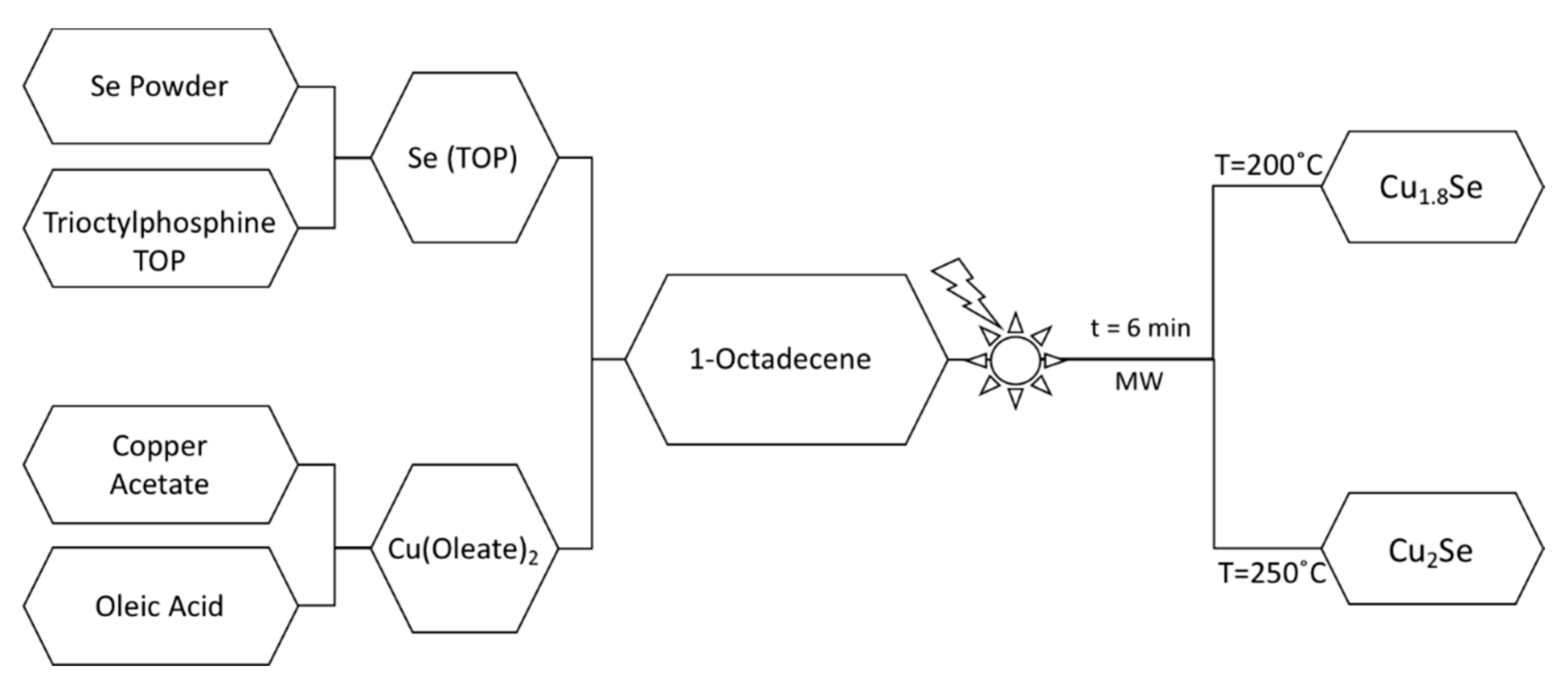

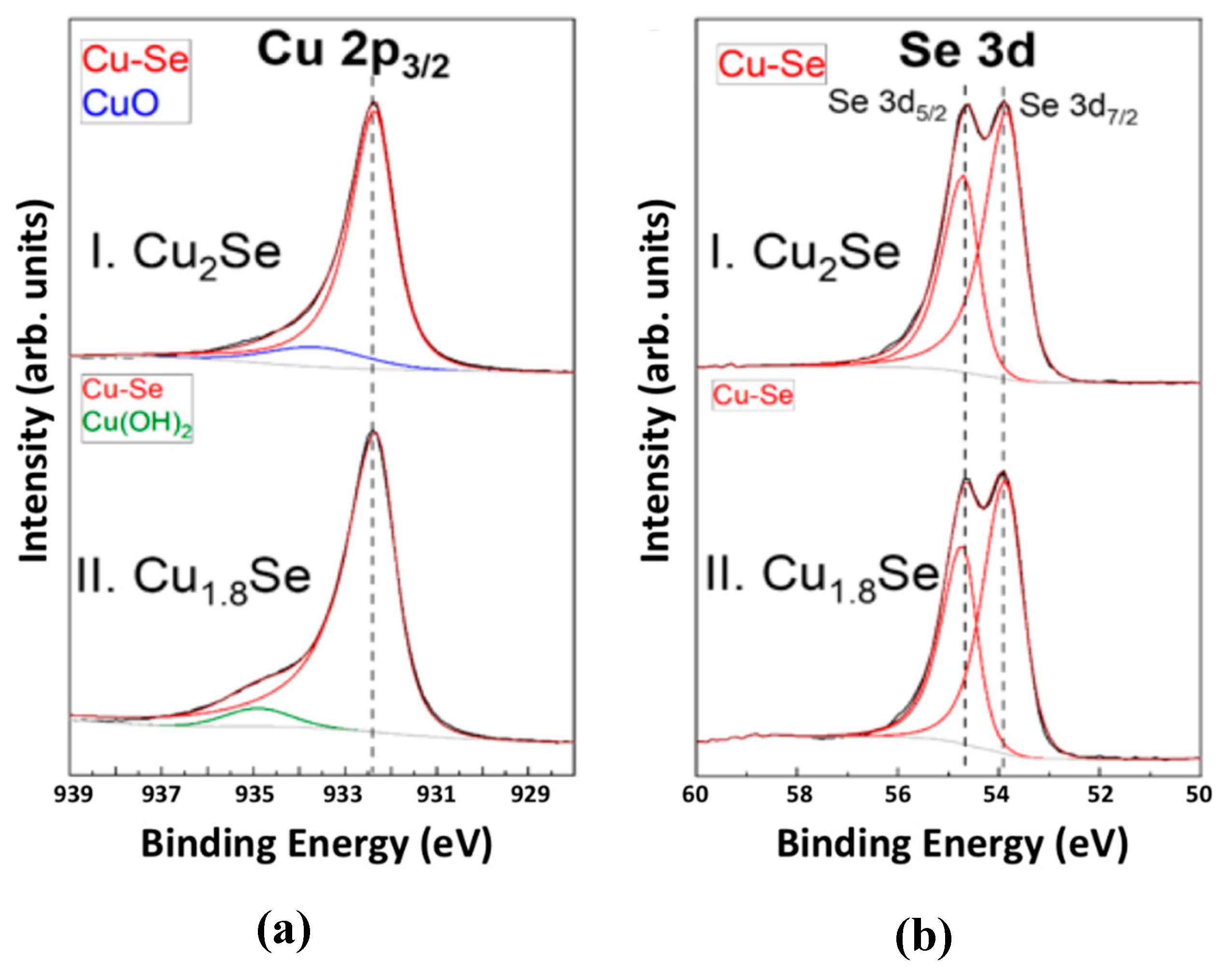
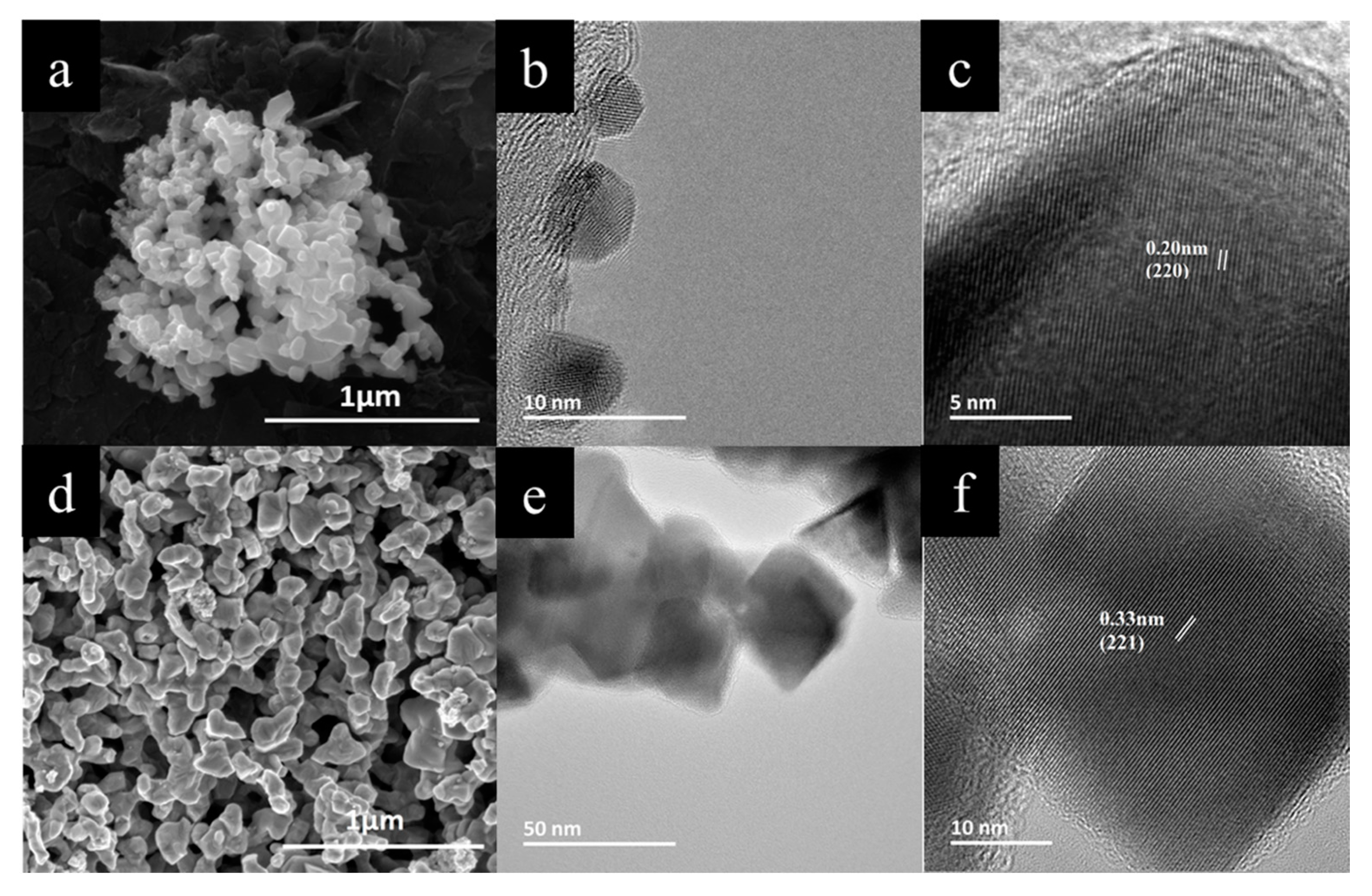
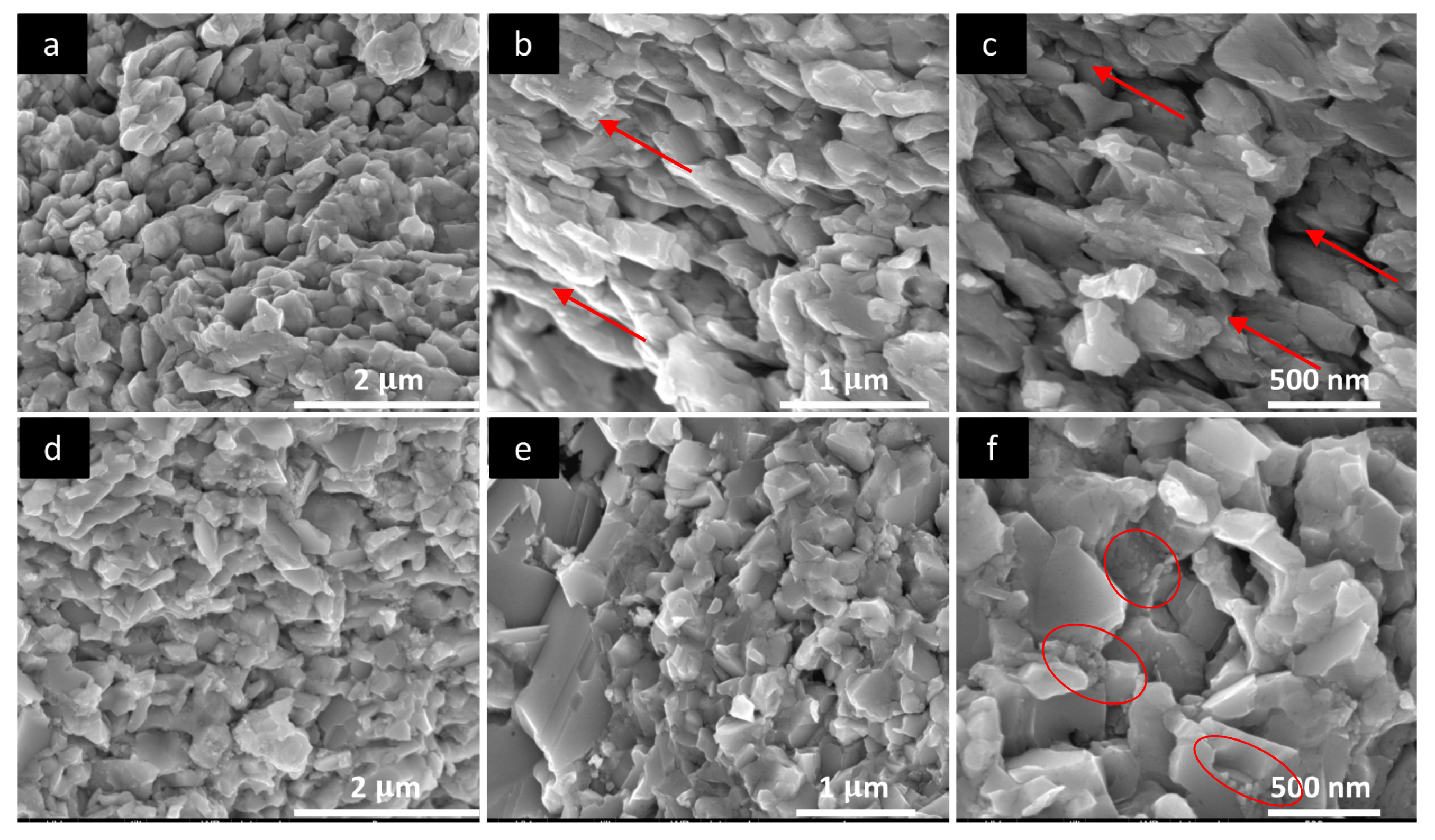
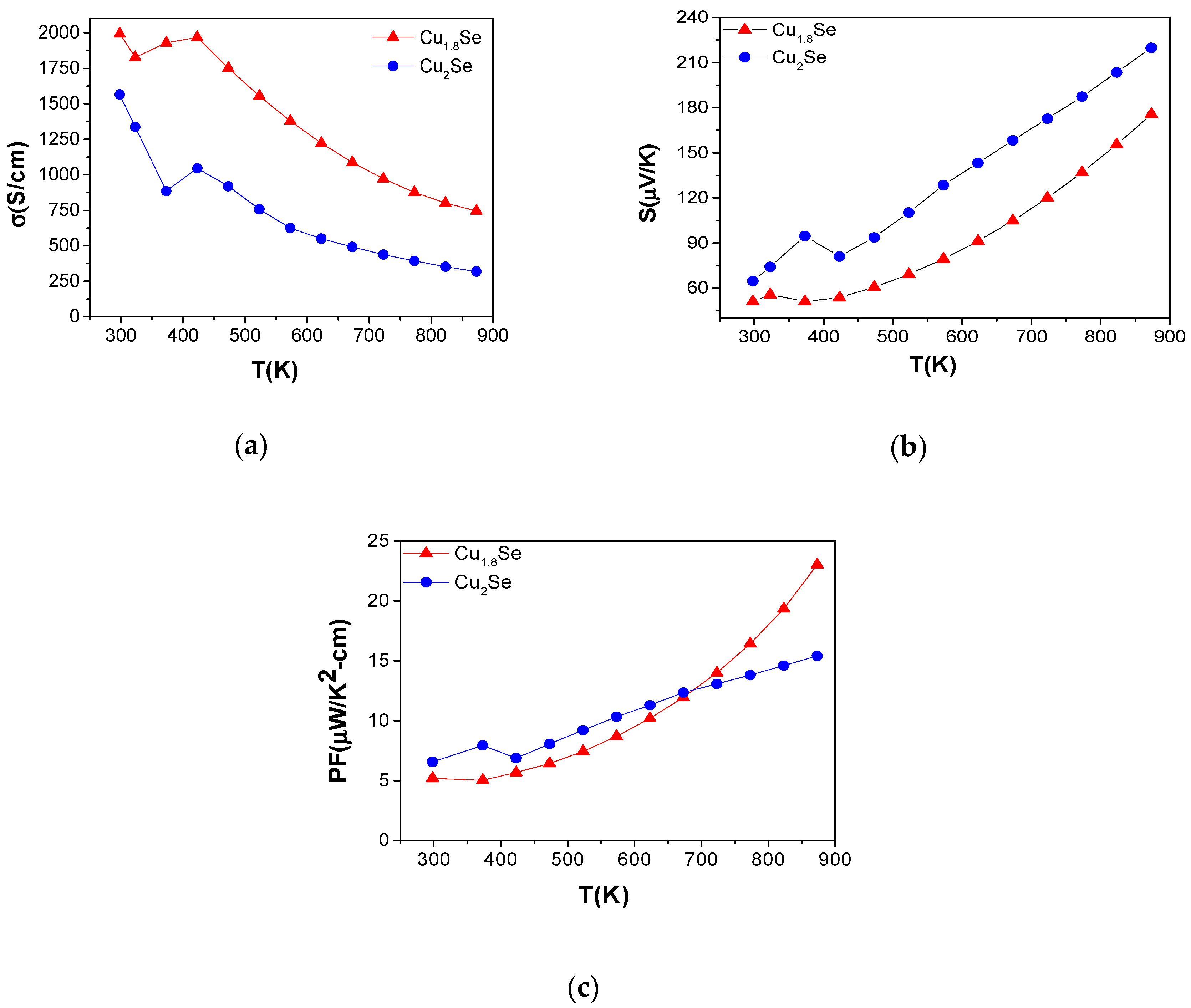
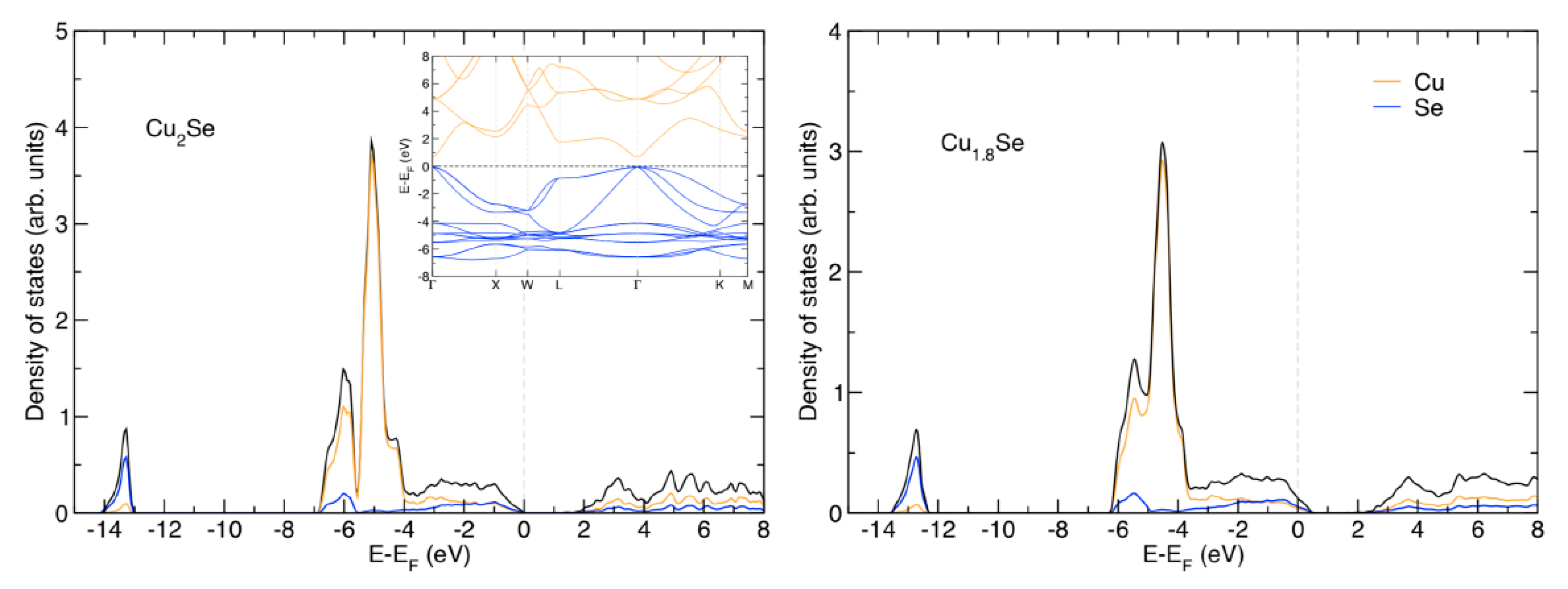


| Sample | Microwave Syn. Parameters | Heating Rate (°C/min) | SPS Temp (°C) | Load (MPa) | Packing Density (g/cm3) | Compaction Density (%) |
|---|---|---|---|---|---|---|
| Cu1.8Se | 200 °C; 5 min | 50 | 300 | 75 | 6.36 | 95 |
| Cu2Se | 250 °C; 5 min | 50 | 400 | 75 | 6.45 | 94 |
© 2020 by the authors. Licensee MDPI, Basel, Switzerland. This article is an open access article distributed under the terms and conditions of the Creative Commons Attribution (CC BY) license (http://creativecommons.org/licenses/by/4.0/).
Share and Cite
Hamawandi, B.; Ballikaya, S.; Råsander, M.; Halim, J.; Vinciguerra, L.; Rosén, J.; Johnsson, M.; S. Toprak, M. Composition Tuning of Nanostructured Binary Copper Selenides through Rapid Chemical Synthesis and Their Thermoelectric Property Evaluation. Nanomaterials 2020, 10, 854. https://doi.org/10.3390/nano10050854
Hamawandi B, Ballikaya S, Råsander M, Halim J, Vinciguerra L, Rosén J, Johnsson M, S. Toprak M. Composition Tuning of Nanostructured Binary Copper Selenides through Rapid Chemical Synthesis and Their Thermoelectric Property Evaluation. Nanomaterials. 2020; 10(5):854. https://doi.org/10.3390/nano10050854
Chicago/Turabian StyleHamawandi, Bejan, Sedat Ballikaya, Mikael Råsander, Joseph Halim, Lorenzo Vinciguerra, Johanna Rosén, Mats Johnsson, and Muhammet S. Toprak. 2020. "Composition Tuning of Nanostructured Binary Copper Selenides through Rapid Chemical Synthesis and Their Thermoelectric Property Evaluation" Nanomaterials 10, no. 5: 854. https://doi.org/10.3390/nano10050854
APA StyleHamawandi, B., Ballikaya, S., Råsander, M., Halim, J., Vinciguerra, L., Rosén, J., Johnsson, M., & S. Toprak, M. (2020). Composition Tuning of Nanostructured Binary Copper Selenides through Rapid Chemical Synthesis and Their Thermoelectric Property Evaluation. Nanomaterials, 10(5), 854. https://doi.org/10.3390/nano10050854







